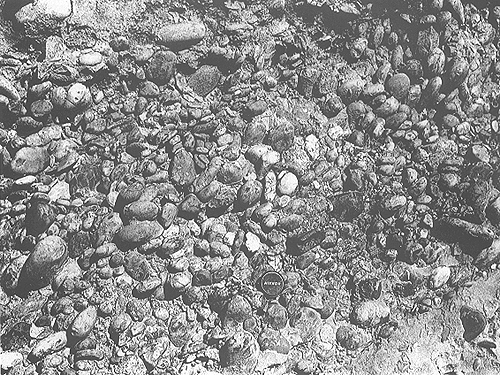
Disorganized conglomerate
Plate 63

Disorganized conglomerate
Plate 63
No bedding or particular fabric is recognizable in this outcrop of a Pliocene conglomerate in fluvio-deltaic deposits of the Pliocene Intra-apenninic Basin. Again, as in the previous example, pebbles are closely packed and touch each other; the particles are said to be self-supported, and the conglomerate grain-supported. With decreasing concentration (see, for instance, plates 66 and 69), pebbles become matrix-supported, or matrix-embedded. A matrix-supported conglomerate is also called a paraconglomerate.
Another observation is that size sorting is not bad but poorer than in preceding and following images (sorting is one of the parameters that define organization). In terms of shape, there is also a moderate sorting, with a predominance of globular, ellipsoidal forms and a small number of elongated and flat clasts. The lack of any fabric, i.e., the arrangement of pebbles in a quite haphazard fashion, is anyway the most impressive character of this conglomerate, which induces us to use the attribute disorganized (or poorly organized). The most obvious reason for it is a catastrophic emplacement by a mass flow, such as a fluvial flood of exceptional violence or a gravity flow. A more selective process would have produced some bedding or preferred orientation of pebbles. The flow energy must have been very high to carry the pebbles with so close a spacing and so little matrix (mud in the matrix lubricates the movement, and solid friction between pebbles is high).
The moderate sorting seems to indicate that the mass flow picked up materials that were pre-sorted in some local repository.